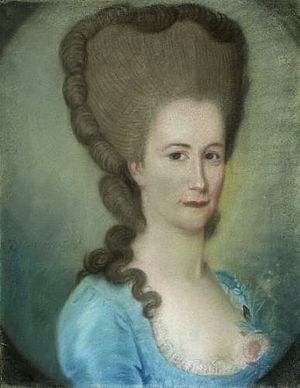Susanna Blamire facts for kids
Quick facts for kids
Susanna Blamire
|
|
|---|---|
 |
|
| Born | 12 January 1747 Cardew Hall, , Cardew, Cumberland |
| Died | 1794 (aged 46–47) |
| Occupation | Poet |
| Nationality | English |
| Literary movement | Romanticism |
| Notable works | 'Stoklewath, or The Cumbrian Village'; 'And ye shall walk in silk attire' |
Susanna Blamire (born January 12, 1747 – died 1794) was an English poet. She is known as a Romantic writer. People sometimes called her 'The Muse of Cumberland'. This is because many of her poems describe country life in Cumberland.
Her poems offer a different view of rural life compared to other famous poets. These include William Wordsworth and Samuel Taylor Coleridge. Susanna wrote many of her poems outdoors. She often sat by a stream in her garden. She also played the guitar and the flageolet, a type of flute. She used these instruments when creating her poetry.
Some people consider Blamire a very important poet. One expert called her 'the greatest female poet' of her time. Another said she was 'as important as the other Romantic poets'.
One of her most famous songs is 'And Ye shall walk in silk attire'. The writer Charles Dickens even mentioned it in his book The Old Curiosity Shop. Her biggest work is a long poem called Stoklewath, or The Cumbrian Village.
Contents
Susanna Blamire's Life Story
Susanna Blamire was born on January 12, 1747. Her birthplace was Cardew Hall, near Cardew, Cumberland. Her father, William Blamire, was a farmer. He died in 1758. Her mother, Isabella Simpson, died earlier in 1753.
Growing Up and Education
Susanna became an orphan when she was young. She went to live with her aunt Mary. Her aunt farmed at Thackwood, Stockdalewath. Susanna first went to a local school called a Dame school. It was in Raughton Head. Later, she had private teachers at home. These teachers came from Sebergham Grammar School.
Family and Friends
Susanna had a brother named William. His son, also named William Blamire, became important. He served as a High Sheriff of Cumberland and a Member of Parliament for Cumberland. Another brother, Richard, was a bookseller in London. He published books by William Gilpin. Through her brothers, Susanna met many writers in London.
Her sister married Colonel Graham. He was an officer in a Highland regiment. This connection gave Susanna friends in Scotland. She traveled with her sister to the Scottish Highlands, London, and Ireland.
In Carlisle, Susanna became friends with Catharine Gilpin. They might have even written poems together. Susanna also knew the important Tankerville family. There was talk of her marrying their son, Lord Ossulton. But their different social backgrounds prevented it. She remained unmarried throughout her life. Susanna was also a friend of the philosopher William Paley.
Illness and Passing Away
Susanna Blamire suffered from a serious heart condition. It was called rheumatic heart disease. This illness caused her death at age 47.
She passed away on April 5, 1794, in Carlisle. She asked to be buried at the chapel in Raughton Head.
Susanna Blamire's Works
Susanna often wrote her poems outdoors. She liked to sit by a stream in her garden at Thackwood. She also played the guitar and the flageolet. Sometimes, she played these instruments while writing. She mostly shared her poems with friends. She even pinned them to trees! Not many of her poems were published while she was alive.
Songs and Music
Some of her poetry appeared in magazines and collections. She secretly sent songs to the Scots Musical Museum. These songs were in a Scottish dialect called Lallans. Famous composer Joseph Haydn set three of her songs to music. These include 'What ails this Heart o' Mine?', 'The Siller Croun' (also known as 'And ye shall walk in Silk Attire'), and 'The Waefu' Heart'. Haydn used German translations to understand the feelings in her lyrics. He then created music that perfectly matched the emotions.
Published Collections
Her complete poems were first put together and published in 1842. The book was called The Poetical Works of Miss Susanna Blamire, The Muse of Cumberland. Two publishers, Patrick Maxwell and Henry Lonsdale, collected her writings. They had been gathering her manuscripts since 1836.
Her poems include different styles. She wrote Gothic stories in standard English. She also wrote songs in Scottish and Cumberland dialects. These dialect poems are similar to those by William Wordsworth and Samuel Taylor Coleridge. She also wrote friendly letters in verse. Her most famous poem, Stoklewath or the Cumbrian Village, describes rural life in great detail.
Influence on Other Poets
Some believe Susanna Blamire's work was ahead of its time. It seemed to predict the ideas of the Romantic movement. This movement was later made famous by William Wordsworth and Samuel Taylor Coleridge.
Her poem The Nun's Return to the World [...] might have influenced Lord Byron's The Prisoner of Chillon. A professor named Jonathan Wordsworth suggested this. He said that when reading Blamire's poem, it sounds like Byron's work.
There are a few reasons why this might be true. Susanna's half-sister, Bridget, was very interested in Susanna's poems. Bridget lived near Annabella Milbanke's house. Annabella later married Lord Byron. It's possible Byron saw Susanna's poems there. Also, Bridget's son, William, tutored Annabella before she married Byron.
Another connection was through Susanna's niece, Mary. Mary's husband, Thomas Young, knew William Wordsworth. He was also a tutor at Cambridge when Byron was a student there. Since Young lived close to the Blamire family, he likely knew about Susanna's writings. A Byron expert, Professor Jerome McGann, believes it's "quite possible" Susanna's poem was in Byron's mind.

